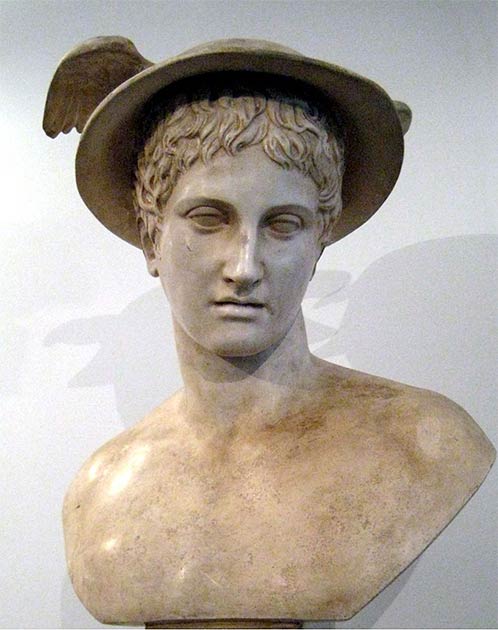Construction workers have made a remarkable discovery in Athens. The Greek Ministry of Culture has announced that the ancient bust of the Greek god Hermes was unearthed in remarkably good condition during sewage work in the heart of the city on Friday 13 th November. It was probably part of a hermaic column, which were once common sights in ancient Athens and elsewhere in ancient Greece .
The Agia Irini (St. Irene) Square is set in downtown Athens and is very popular with residents and visitors alike. Some construction workers were working on a sewage project when they came across the major find. The sculpted head was uncovered at a “depth of 4.2 feet (1.3 meters),” reports DH. At first experts believed that the head was a depiction of Zeus. However, further investigations revealed that it was a marble bust depicting the god Hermes.

The Greek Ministry of Culture has announced the unexpected find of an ancient head of Hermes during construction work in Athens. ( Greek Ministry of Culture )
Unusual Mature Head of Hermes
According to Archaeology News Network , “the head was found in the south side wall of a modern sewage pipeline.” Despite this, the head was in a remarkable condition. AP News explains that the head “depicts Hermes at ‘a mature age’.” This is most unusual. Typically, Hermes is shown as a beardless young man in ancient art.
Based on the style of the bust, it probably dates to approximately 300 BC, during a period known as the Hellenistic Age . The Greek Ministry of Culture stated that “the head is in the style of famed Greek sculptor Alcamenes,” reports USA Today . Alcamenes, or Alkamenos, flourished in the 5 th century BC and was considered one of ancient Greece’s finest sculptors.

Hermes is usually depicted as a young beardless man in ancient art, making the find even more unusual. (shakko / CC BY-SA 3.0 )
Hermes: Messengers of the Gods
Hermes, son of Zeus, was one of the twelve Olympians. His primary role was as the messenger of the Gods. However, he was also the patron deity of diplomacy trade, boundaries, diplomacy, travel, flocks, and thieves. Hermes in the myths is portrayed as very clever and craft and this led Zeus to appoint him the messenger of the Gods. He was worshipped by a wide range of groups including travelers, merchants, athletes, and shepherds.
Hermes is credited with the invention of the lyre and the plectrum. He was the protector of travelers and this included protecting the dead traveling to the underworld. At Ancient Origins we reported that “Hermes is believed to be a psychopomp, one who was responsible for conducting the souls of the deceased into the Underworld.” His image was frequently depicted on grave markers in ancient Greece .
The god is often portrayed with a staff, a broad-brimmed hat and winged sandals that allowed him to travel very quickly. It was believed that the touch of his staff could make mortals fall asleep. His Roman counterpart was Mercury, another the messenger of the gods.
Hermaic Columns as Protectors of Travelers
DH reports that “the bust is likely a fragment of a Hermaic column – which were established at crossroads and streets and served as road signs.” These columns, also known as hermae or herma, were statues of Hermes, the messenger of the gods. They were boundary markers, and thought to give travelers protection. This was very necessary because travel was dangerous in ancient Greece, due especially to war and bandits.
Hermaic columns were regarded with religious awe by Greeks and to deface one was an act of terrible sacrilege. It has been recorded that the defacement of several hermae in ancient Athens was utilized by the many enemies of Alcibiades, an important general and statesman in the Peloponnesian War (431 to 404 BC), to engineer his downfall. Later, the Romans and others adopted these columns for decorative purposes.
The Greek Ministry of Culture is quoted by DH as saying in a statement that “after serving as a street marker, the head, at some point had been built into the wall of a drainage duct.” This may have happened when the column had lost its religious significance. Ironically, this possibly helped to preserve the remarkable bust. The discovery was immediately transferred to a warehouse overseen by the Ephorate of Antiquities, where it will be safely stored.
Top image: The Greek Ministry of Culture has announced that an ancient bust of Hermes, said to be over 2,300 years old, was unearthed last Friday in Athens in surprisingly good condition. Source: Greek Ministry of Culture
By Ed Whelan
Related posts:
Views: 0
 RSS Feed
RSS Feed

















 November 17th, 2020
November 17th, 2020  Awake Goy
Awake Goy  Posted in
Posted in  Tags:
Tags: 
















